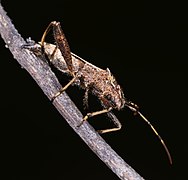
Pentatomidae is a family of insects belonging to the order Hemiptera, generally called shield bugs or stink bugs. Pentatomidae is the largest family in the superfamily Pentatomoidea, and contains around 900 genera and over 4700 species. As hemipterans, the pentatomids have piercing sucking mouthparts, and most are phytophagous, including several species which are severe pests on agricultural crops. However, some species, particularly in the subfamily Asopinae, are predatory and may be considered beneficial.

Gottlieb August Wilhelm Herrich-Schäffer was a German entomologist and physician. He was born, and died, in Regensburg. Herrich-Schäffer studied and collected particularly butterflies and moths (Lepidoptera). He was chairman of the Regensburg Botanical Society from 1861 to 1871, and was awarded an honorary citizenship of Regensburg in 1871.
Georg Wolfgang Franz Panzer was a German botanist and entomologist.

Alydidae, commonly known as broad-headed bugs, is a family of true bugs very similar to the closely related Coreidae. There are at least 60 genera and 300 species altogether. Distributed in the temperate and warmer regions of the Earth, most are tropical and subtropical animals; for example Europe has a mere 10 species, and only 2 of these occur outside the Mediterranean region.

Leptoglossus is a genus of true bugs in the leaf-footed bug family and the tribe Anisoscelini. Species are distributed throughout the Americas, with some records in eastern & southern Asia and Europe. Several species are economic pests of agricultural crops. Like members of some other genera in the family, these bugs have leaflike dilations of the hind tibia. Several species are of economic importance, and one species, L. chilensis, has been reported to bite humans.
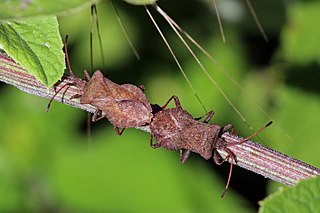
Coreus marginatus is a herbivorous species of true bug in the family Coreidae. It is commonly known as the dock bug as it feeds on the leaves and seeds of docks and sorrels. It is a medium-sized speckled brown insect, between 13 and 15 mm long as an adult, with a broad abdomen. It occurs throughout Europe, Asia and northern Africa. It is often found in dense vegetation, such as hedgerows and wasteland.
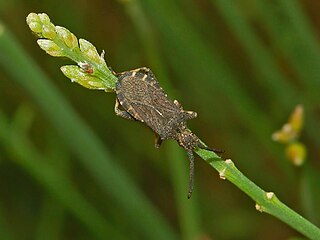
Bothrostethus annulipes is a species of the Coreidae family, a subfamily of the Pseudophloeinae.

Liorhyssus hyalinus is a species of scentless plant bugs belonging to the family Rhopalidae, subfamily Rhopalinae.
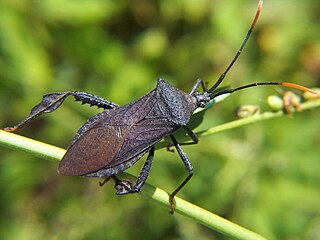
Acanthocephala, also known as spine-headed bugs, is a New World genus of true bugs in the family Coreidae. The scientific name is derived from the Greek ἄκανθα (akantha) meaning "thorn/spine" and κεφαλή (kephale) meaning "head". This name refers to the diagnostic spine on the front of the head.

Gonocerus acuteangulatus is a herbivorous species of true bug in the family Coreidae. It is commonly known as the box bug in the UK as it once only occurred in Box Hill in Surrey where it fed on box trees.

Gelastocoris is a genus of toad bugs in the family Gelastocoridae. There are more than 20 described species in Gelastocoris.

Mozena is a genus of leaf-footed bugs in the family Coreidae. There are more than 30 described species in Mozena.
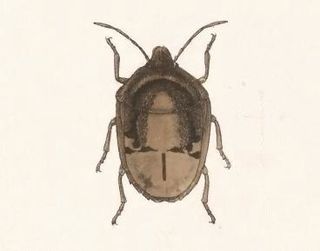
Symphylus is a genus of shield-backed bugs in the family Scutelleridae. There are at least four described species in Symphylus.
Temnostethus is a genus of minute pirate bugs in the family Anthocoridae. There are about eight described species in Temnostethus.
Mozena brunnicornis is a species of leaf-footed bug in the family Coreidae. It is found in Central America and North America.

Nagusta goedelii is a species of assassin bugs in the family Reduviidae.

Leptocorisa is a genus of broad-headed bugs in the family Alydidae. There are about 17 described species in Leptocorisa, some of which are known as "rice bugs" or gundhi bugs ; they are found in south and east Asia and in Oceania.

Dipsocoridae are a family of heteropteran bugs known as jumping ground bugs. There are about 30 widely distributed species which are placed in three genera. Fossils from Eocene amber have also been placed in the family.


